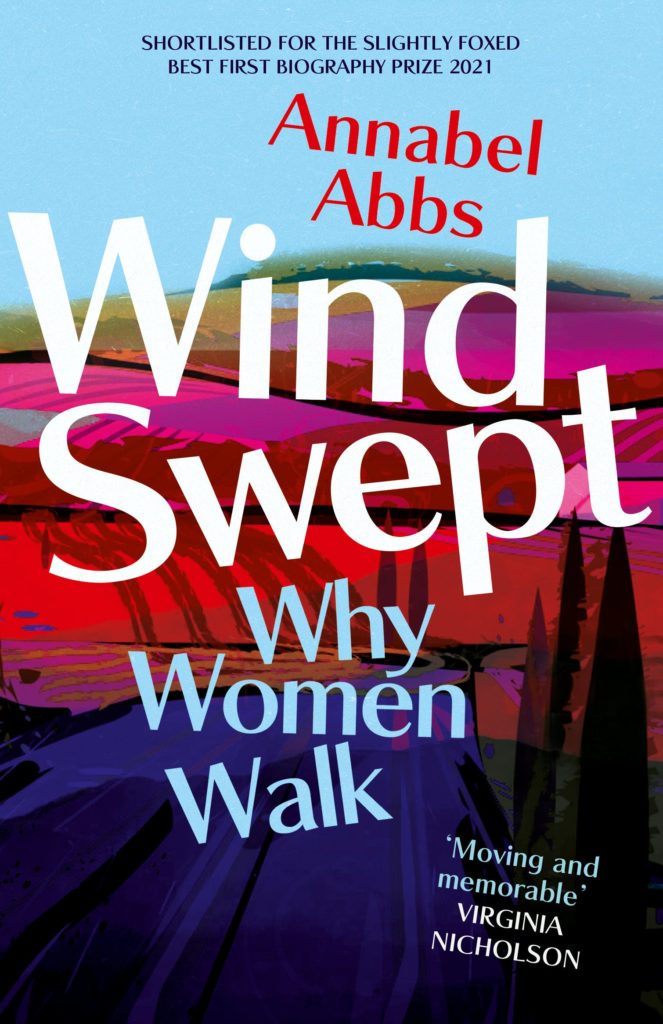Recently issued in paperback by John Murray Press, Annabel Abbs’ ‘Windswept: Why Women Walk’ tells the stories of six extraordinary women who lost their way — their sense of self, their identity, their freedom — and found it again through walking in the wild. Clare Wadd reviews.

In this inspirational book, combining biography and memoire, Annabel Abbs combines walking with celebrating the remarkable women who walked before her.
Like many of us, she was slow to notice all her walking books were by men, and then wondered if that was why she hadn’t found them inspiring. It’s always been hard to relate to men’s casualness, fearlessness and ‘easy uncomplicated swagger’. Abbs quotes Werner Herzog: ‘where I’m going to sleep doesn’t worry me’, but women face additional complexity and rarely get to be so casual. Her shelf of walking books wasn’t ‘men or adventures I could emulate’, and she was angry at men’s unexamined dominance. ‘Solitude is not only for other people, wild rural spaces are not only for men’.
This led to research — surely women must always have walked? Surely there must be women known for walking other than Virginia Woolf? She found sepia photos of unknown women dressed in long trailing skirts and tight corsets walking and climbing, and eventually this all led to Windswept, an exploration of the walking lives of six remarkable women.
Abbs chose a group of women for whom rural walking had been life-changing. They walked not to enjoy ‘all the freedom a man is capable of having’ or for exercise but to find minds of their own, understand their bodies, assert their independence, and become the people they wanted to be. She follows in their footsteps across Europe and in the US — over deserts and plains, through valleys and mountain ranges, in dark frightening forests, and along rivers — deftly weaving her walking story into theirs, so well you can barely spot the joins. And as she walks, the things she’s escaping take shape too — Windswept is about tracks of thoughts as much as tracks underfoot. ‘When I return home, I am enriched and emboldened, my future has acquired promise and possibility and hope.’
The remarkable convention-defying women are: Frieda Lawrence; Gwen John; Clara Vyvyan; Nan Shepherd; Simone de Beauvoir; and Georgia O’Keefe, but others including Daphne du Maurier feature too. Some are best known by their connection to the men in their lives: Frieda Lawrence was an author and translator married to D.H., and Gwen John was Augustus’ sister and Rodin’s lover, but was herself a painter, with portraits and self-portraits in The Tate and National Portrait Gallery. Simone de Beauvoir might seem inextricably linked to Jean Paul Sartre; we imagine her chic in cafes of the Left Bank, but she was a courageous hiker who roamed the hills around Marseille, windswept and sunburnt, often alone, never with Sartre. Like so many of us, she needed both the urban and rural, and said ‘one should always see dawn and sunset alone’.
These women walked in shorts with long skirts rolled up ready to be whipped down when approaching houses. They’re repeatedly turned away from accommodation due to fear and suspicion, are relentlessly pestered by men, and end up sleeping in haystacks and living like tramps. Some of them would walk for three months with a single set of clothes, and Abbs celebrates the joy of modest needs, that we can exist with little more than a change of clothes (though she is alive to the difference between doing this by choice and necessity, with a nod to another woman’s walking book The Salt Path, its walk resulting from homelessness and limited options).
Previous generations of women were very much trapped in their homes, with a pilgrimage the only time it was acceptable to leave and just walk. And so Abbs ends up, when walking the River Garonne from Bordeaux to Toulouse alone, telling people she’s on a pilgrimage, because, even now, that seems more acceptable than simply: I’m walking. On my own. Because I want to.
It’s comforting to read about the reality of other women’s walking lives: the universal panic when your period arrives, not just the extra laundry, but the potential for humiliation, and sanitary pads improvised from sphagnum moss or sheep’s wool. The courage of others is contagious, and ‘valiant women can breathe hope and fortitude into other women’. To be alone in the wilds risked their reputations as well as physical safety. She writes about strange men following you, the harassment that historically (and still) accompanies women walking in remote landscapes, feeling unable to walk alone. We’re the same generation and both grew up with the Yorkshire Ripper as the backdrop to adolescence; mine was in Yorkshire, not far from his hunting ground, and I was in my thirties before I really began to question the fact I shouldn’t be outside on my own on foot after dark. Thankfully we’ve both ‘shaken off long-held fears of being alone in unpeopled places’.
Abbs shares a brilliant poem by Elizabeth Austen that I hadn’t come across previously, and which sums up beautifully why we walk: ‘because the animal in me needs to fill her nose with the scent of stone and lichen, ocean salt and pine forest warming in the sun’. Its closing line is: ‘the girl who goes alone says with her body the world is worth the risk’. We go alone. And it is worth it.
*
‘Windswept: Why Women Walk’ is out now in paperback and available here (£10.22).